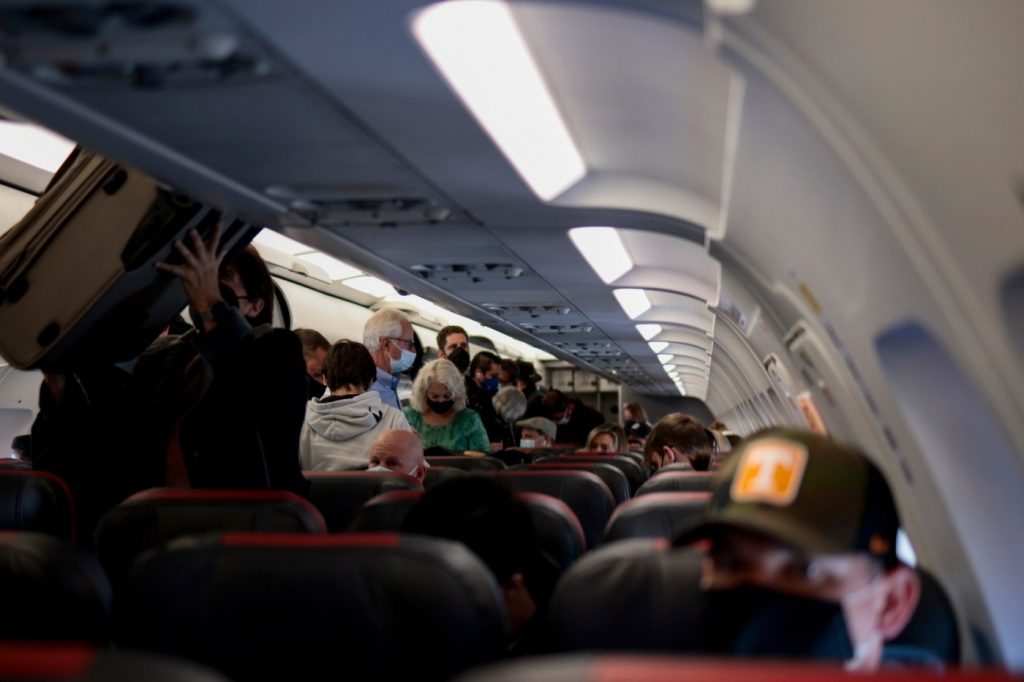By Sally French | NerdWallet
Airlines devote a lot of energy and strategy to how passengers board an aircraft. Passengers are separated into different groups — like preboarding, priority boarding, family boarding, zones 1-7, A 1-60 and so on — and embark accordingly. Some airlines have up to 10 different boarding groups.
You’d think airlines would make the exit process more structured, too, but in reality, neither experts nor passengers can agree on the right way to do it.
Imagine this: Upon arrival, passengers in the middle of the plane are slow to stand up to signal a start to disembarking. In response, a plucky flyer from a row farther back whizzes up to the front to take their turn in the queue of exiters, thereby “cutting” the line.
Is this bad or selfish behavior? Etiquette experts think so.
“It’s common courtesy to allow others to go ahead of you,” etiquette expert Jo Hayes explained in an email. “Be patient, and allow them time to get into the aisle and grab their bag from overhead.”
But just because many people consider it polite to let the people in the prior rows offboard first, is it the most efficient? Turns out, it might not be.
The most efficient way to exit a plane
A 2014 study published in the Journal of Air Transport Management from researchers at Northwestern University’s Department of Industrial Engineering and Management Sciences sought to find the optimal deplaning strategy by simulating the exit process on three types of commercial airliners and using three different algorithms.
The study concluded that deplaning in a “column style” is fastest. That means that starting from front to back, all aisle seats exit first, then all middle seats and then all window seats.
A 2007 study out of the National University of Defense Technology in Changsha, China, found similar results. Across 100 simulations, the column style was the fastest, taking just 9.9 minutes, compared to 14 minutes with the more typical front-to-back approach.
Despite its proven efficiencies for exiting aircraft, the column style might not be that practical. After all, for groups sitting in a row together, the aisle folks who deplane before their companions may end up waiting outside the gate anyway.
The most polite way to exit a plane
Alas, etiquette often trumps efficiency.
“As a general rule, the unspoken plane exit etiquette is to allow those closest to the door to exit first,” Hayes said. “It is basic good manners to wait your turn.”
For some, the rationale comes down to personal space.
“If we all wait and get up as each row in the front gets emptied, it’s easier for everyone to disembark without having to rub each other’s backs and shoulders,” says Sahana Kulur, a travel blogger who runs a website called Vacaywork.
That said, not everyone agrees that letting the slowpokes who fumble with their bags in the overhead bins off first is more polite. Some believe that common courtesy is to let others off the plane as they’re ready, even if that means letting them go in front of you.
When to let people behind you deplane first
There are some situations when it’s generally considered polite to let the people behind you deplane first.
Tight connections
Dwindling time between an arrival and another departure can be stressful, so its courteous to let passengers with tight connections exit early.
“If you have a tight connecting flight, particularly due to a delay in departing, you should let the flight attendants know,” Carrie Bradley, a former flight attendant who now runs a travel blog called Flying With A Baby, said in an email.
Flight attendants can then announce on the overhead speaker that some passengers might need to rush out, or they might reshuffle seats to put connecting passengers near the front.
If the connecting passenger is you, let people in the rows ahead of you know why you’re skipping ahead.
Your bags are stowed in overhead bins behind you
While storing your bag above your seat is ideal, stowing it toward the front of the plane is your next best bet for maximizing deplaning efficiency.
But if your bags end up in an overhead bin behind you, don’t hold up everyone so you can retrieve your bags. At the very least, let the rows between you and your bag get off before you.
You don’t want to deal with the rush to exit anyway
Hayes generally prioritizes etiquette when deplaning and says she prefers the row style, even though she sometimes strays from it to avoid the hubbub.
“If I’m in a window seat, I’ve allowed the hordes to get up and leave before disembarking,” she said. “I can spend those extra few minutes checking my phone or simply relaxing calmly.”
How to disembark better (and faster)
No matter where you’re seated, most agree on some standards that make disembarking kinder and faster for everyone.
“Be quick to offer assistance to others in getting bags down from overhead,” Hayes wrote. “Those who are shorter, or the elderly, are often supremely grateful for assistance.”
“There’s no need to leap out of your seats as soon as the seat belt signs are off,” Bradley said. “Instead, spend that time checking the seat and floor around you to make sure that you have everything.”
But she still encourages travelers to pay attention and disembark quickly.
“Be ready to go as the rows in front of you are starting to move.”
And if unstructured disembarking is too much to bear, you can always pay extra or use upgrades to sit toward the front of the plane in a higher class of service. Even within the main cabin, you can often purchase a premium economy fare for more leg room, earlier boarding and, yes — a likely earlier exit than those farther back.
More From NerdWallet
Turo Flips Car-Rental Script: Pick the Car, Then the Destination
How Timeshare Presentations Earn Me Cheap Travel
There Are New Digital Nomads on the Block: Families
Sally French writes for NerdWallet. Email: [email protected]. Twitter: @SAFmedia.
The article Is There a Right Way to Exit an Airplane? originally appeared on NerdWallet.


